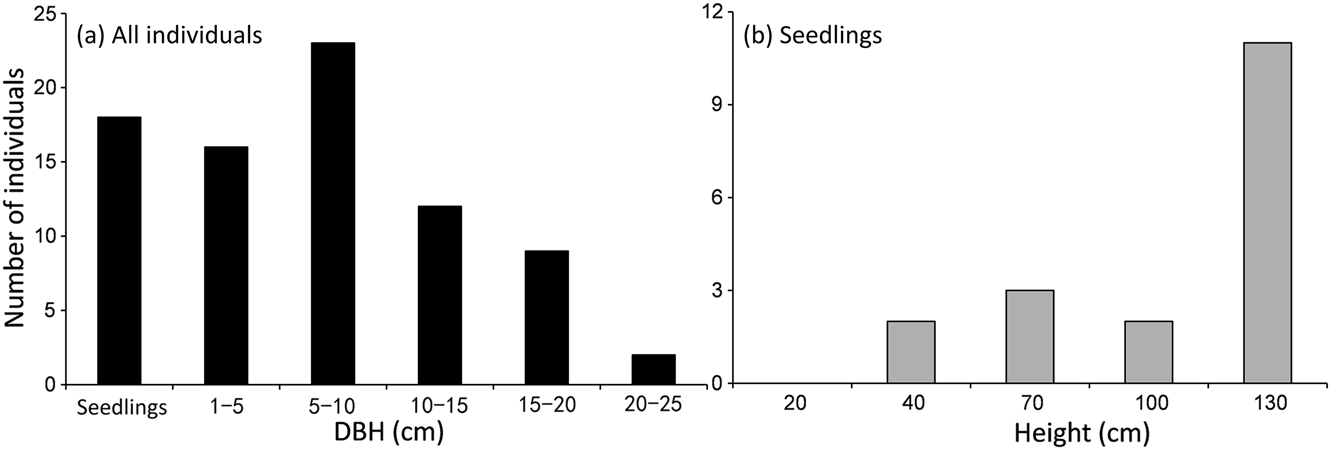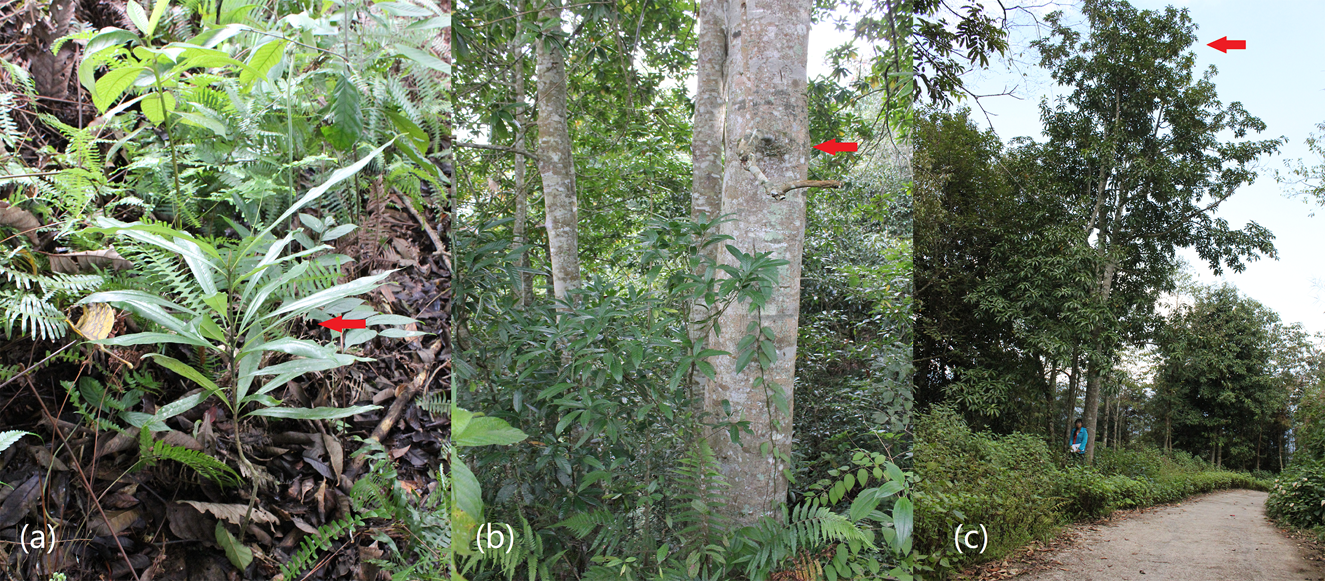The plant family Magnoliaceae has a disjunctive geographical distribution: two-thirds of species occur in Asia, the others in Central America and northern South America (Liu, Reference Liu2004; Cicuzza et al., Reference Cicuzza, Newton and Oldfield2007; Xia et al., Reference Xia, Liu, Nooteboom, Wu and Raven2008). The family comprises c. 314 species, of which 147 (46.8%) are threatened in the wild (Rivers et al., Reference Rivers, Beech, Murphy and Oldfield2016). China and Latin America are the hotspots for Magnoliaceae (Rivers et al., Reference Rivers, Beech, Murphy and Oldfield2016). There are c. 108 species in China, of which 78 are in south-west China (Shui, Reference Shui2003; Xia et al., Reference Xia, Liu, Nooteboom, Wu and Raven2008). This area is a biodiversity hot-spot, with > 13,000 vascular plant species, of which c. 29% are endemic (Chen et al., Reference Chen, Lu, Zhu, Tamaki and Qiu2017). Of these, 38 species belong to Magnoliaceae (Chen et al., Reference Chen, Lu, Zhu, Tamaki and Qiu2017), and one of the most seriously threatened is Magnolia ovoidea (Hung T. Chang and B.L. Chen) V.S. Kumar, categorized as Critically Endangered (Rivers et al., Reference Rivers, Beech, Murphy and Oldfield2016), and as a Plant Species with an Extremely Small Population (Ma et al., Reference Ma, Chen, Grumbine, Dao, Sun and Guo2013).
The first specimen of M. ovoidea was collected in Maguan County, Yunnan, by Baoliang Chen in April 1986 (Chen, Reference Chen1988). We obtained information on this species from Flora Yunnanica (Law, Reference Law and Wu2006), Flora of China (Xia, et al., Reference Xia, Liu, Nooteboom, Wu and Raven2008) and Magnolias of China (Liu, Reference Liu2004), and examined all specimens in the Chinese Virtual Herbarium (CVH, 2015), to determine the species’ range. Based on the specimens and habitat of M. ovoidea, we conducted field surveys in eight counties of Wenshan Prefecture in Yunnan during 2012–2015, during which we also interviewed a total of 24 local foresters from all counties surveyed, showing them photographs and specimens of M. ovoidea, to obtain additional information on the species. Our surveys and the interviews indicated that M. ovoidea occurs only in Maguan County, at altitudes of 1,460–1,700 m.
In October 2016, to investigate the size structure of the population and to assess any potential threats, we surveyed all known populations. We recorded the position of all living individuals with a GPS, noting habitat characteristics and any evidence of disturbance. The Townships of Miechang and Bazhai, Maguan County (Fig. 1), where the known individuals were found, have a mean annual temperature of 22.8 °C, with a mean minimum temperature of −4 °C in January and a mean maximum of 32.3 °C in July (Zhou et al., Reference Zhou, Jiang, Yang, Zhang and Xiang2012), and mean annual total precipitation of 1,254 mm.

Fig. 1 The six known localities (Table 1) of Magnolia ovoidea, in Bazhai and Miechang Townships in Maguan County, Yunnan, China.
Table 1 Characteristics of the six known localities of Magnolia ovoidea in Maguan County (Fig. 1).

For all M. ovoidea located, we recorded the diameter at breast height (DBH) and height of all living individuals ≥ 1.3 tall, and counted and measured the height of all seedlings (height < 1.3 m). A total of 62 individuals ≥ 1.3 m tall and 18 seedlings were recorded (Table 1; Plate 1). As a whole, the DBH of the population has an inverse J-shaped distribution, with most individuals in the 5–10 cm class (Fig. 2). Such a distribution indicates a stable population structure in which naturally senescent individuals are replaced with seedlings and saplings (Tang et al., Reference Tang, He, Gao, Zhao, Sun and Ohsawa2011; Ren et al., Reference Ren, Jian, Chen, Liu, Zhang and Liu2014; Qian et al., Reference Qian, Yang, Tang, Momohara, Yi and Ohsawa2016). However, of the six sites, seedlings were only found in Donggua Lin, Maocao Zhai and Youfang Po, and the distribution of seedling height is L-shaped, with fewest seedlings in the smallest classes. The persistence of small populations usually depends on a few mature plants and is therefore highly vulnerable to factors limiting seedling recruitment (Tang et al., Reference Tang, He, Gao, Zhao, Sun and Ohsawa2011; Qian et al., Reference Qian, Yang, Tang, Momohara, Yi and Ohsawa2016).

Fig. 2 The frequency distribution of (a) the diameter at breast height (DBH) of all living individuals, and (b) the height of all seedlings (height < 1.3 m or DBH < 1.0 cm) of M. ovoidea in Maguan County (Fig. 1).

Plate 1 (a) M. ovoidea seedling, and (b) and (c) adult M. ovoidea in Youfang Po (Fig. 1).
Magnolia ovoidea is threatened by habitat degradation and fragmentation. In the six locations, vegetation clearing for planting of crops is ongoing, and we witnessed M. ovoidea being felled or partially felled (all six locations are in unprotected areas). All locations are surrounded by roads, farmlands, and Alnus nepalensis or Cunninghamia lanceolata plantations (Table 1). The restricted area of vegetation, and human activities, are probably limiting the recruitment of M. ovoidea seedlings.
Rivers et al. (Reference Rivers, Beech, Murphy and Oldfield2016) categorized M. ovoidea as Critically Endangered based on criterion (IUCN, 2012) D (i.e. total number of mature individuals < 50). Our findings support the categorization as Critically Endangered but based on alternative criteria. The total extent of occurrence across the Bazhai and Miechang Townships is 2,600 m2 (< 10 km2), the total number of mature individuals is < 250, and the number of individuals in each subpopulation is < 50, and therefore the appropriate criteria are B2ab(iii) + C2a(i).
For endemic and narrowly distributed species habitat destruction and human disturbance increase the risk of extinction. A small population size and fragmented habitats are likely to reduce the viability of such species (Li et al., Reference Li, Zhang and Zhang2014; Wang et al., Reference Wang, Ma, Chen, Li, Dao and Sun2015). It is not unusual for extremely restricted endemics to survive with < 5 subpopulations (Martinell et al., Reference Martinell, López-Pujol, Blanché, Molero and Sàez2011), and such species may be best managed by local conservation efforts (Crain et al., Reference Crain, Sánchez-Cuervo, White and Steinberg2015), in this case for all of the remaining six populations. We plan to collect seeds for cultivation and ex situ conservation in the Germplasm Bank of Wild Species in Southwest China (Li et al., Reference Li, Yang, Wang and Cai2010), and to study the genetic diversity of this species. Our approach to the conservation of M. ovoidea may be applicable for other plants species with extremely small populations in China (Ma et al., Reference Ma, Chen, Grumbine, Dao, Sun and Guo2013), many of which are threatened.
Acknowledgements
This study was supported by grants from the National Science and Technology Basic Resources Investigation Special Project (2017FY100100), the NSFC-Yunnan Joint Fund (U1602264) and Mohamed bin Zayed Species Conservation Fund (12053820).
Author contributions
Surveys: CH, LT; data analysis: CH, LT, WS; writing: CH; revision: WS.
Conflicts of interest
None.
Ethical standards
This research abided by the Oryx guidelines on ethical standards.








